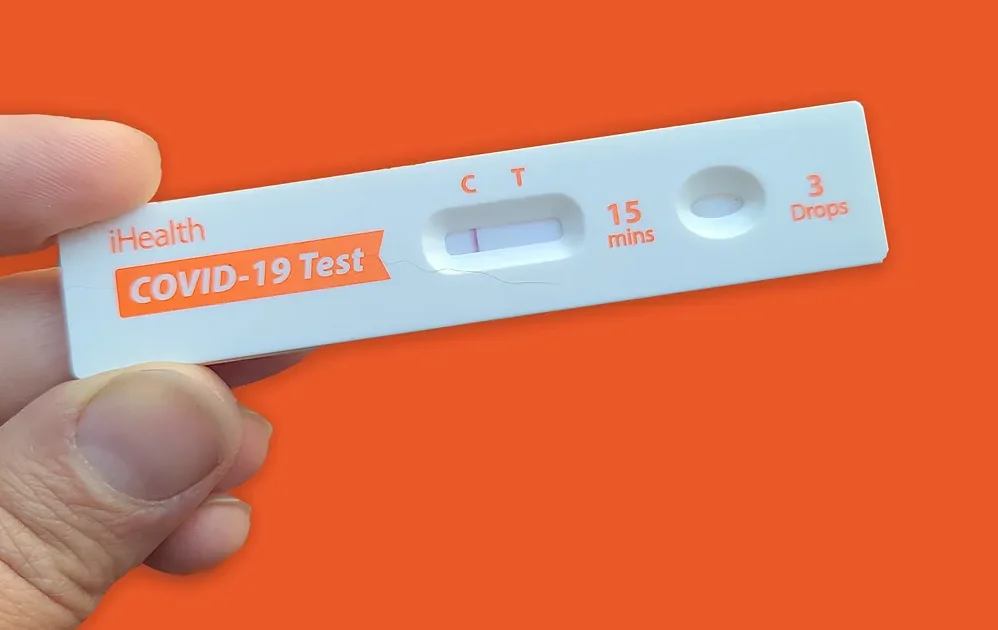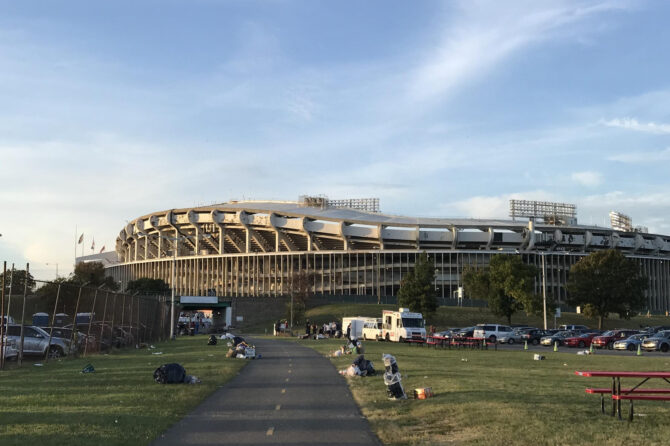MARYLAND MATTERS: Emily Withnall caught COVID-19 from her teenager in July 2020. In the more than two years since, the 40-year-old has suffered from debilitating fatigue, spinal pain and heart palpitations. In addition to her primary care doctor, she regularly sees a cardiologist and says her acupuncturist and craniosacral therapy help relieve her pain and the trouble she has focusing.
Although her condition is improving, Withnall said she still isn’t back to her pre-COVID-19 health and she’s had to ask her employer, New Mexico Highlands University, for accommodations, which include time off to go to her various medical appointments and the ability to work remotely. When she does commute, it takes her an hour to get to the office
“There were a couple of times I had to commute and that was really, really hard and exhausting just physically,” she said. It doesn’t take much to cause a health setback. A simple cold can last weeks so she worries about getting the flu or, even worse, COVID again.
“I have no idea how bad it could be for me,” she said.
Long COVID, which the Mayo Clinic classifies as suffering from new, returning or ongoing symptoms, can include fatigue, chest pain, joint pain, dizziness, headaches, digestive issues, blood clots and brain fog, which makes it difficult to concentrate.
Sixteen million people of working age in the U.S. suffer with long COVID and of those, from 2 to 4 million people were unemployed in June and July, according to an August 2022 Brookings Institution report, which analyzes Census Bureau survey information. It’s one of numerous papers, surveys, and studies attempting to assess the effect of long COVID on workers, businesses and the overall economy.
The unemployment of so many Americans with long COVID, a lack of a social safety net for many of them, and a labor market that is beginning to turn in favor of employers could collide to create wider economic problems, some economic experts say.
The cost in lost wages has already been great. The Brookings Institution report puts the amount between $170 billion to $230 billion a year. And a National Bureau of Economic Research paper published in September found that workers with COVID-19 absences could see their earnings fall by about $9,000 in the 14 months afterward.
Andrew Goodman-Bacon, a senior research economist with the Federal Reserve Bank of Minneapolis, said it’s unclear how the spending habits of people with long COVID will be affected by their illness.
“Some households will certainly have to cut back,” he said. “But some subset of those households will also have ways to sort of insure themselves or be insured by these public programs. … What is aggregate spending going to look like if we enter a recession with a large group of workers with a health condition, a newly acquired health condition hard to predict? It will pull a lot of these levers in the economy, some of which will make consumption patterns change more and some of which might kind of push the other direction.”
Goodman-Bacon added, “The health of the workforce really does matter and it’s mattered for a long time … We’re all really trying to understand the same questions of just how much and right now we don’t know.”
Taking care of workers
Withnall said that at the beginning of the pandemic she was living in Missoula, Mont., and teaching creative writing at schools. That work ended when schools shut down. It also became harder to place her freelance writing.
Then her landlord raised the rent.
“The real estate prices were skyrocketing, and still are actually, and so as a single parent with a meager freelance income and very little teaching left, I was just really, really struggling even with the unemployment benefits,” she said in a phone interview. “I was also really not able to work a lot because of how bad my COVID symptoms were.”
She said for the first six weeks after she tested positive for COVID, her neck and back “felt like it had been turned into concrete.” At one point, a walk to the bathroom could leave her gasping for air. She ended up in the emergency room three times.
She still struggles financially because of health care costs despite her job as associate director for communications at the university and writing a few articles each month as the economic justice fellow for the nonprofit Community Change.
“I also don’t have savings or the ability to even think about bigger things like buying a house,” she said. “My oldest teen just started college and I can’t afford to help pay for it at all. I’d love to be able to put the money I’m paying in medical expenses towards my teen’s college, but that’s not yet possible. I’m still hoping that full recovery from long COVID will happen, but we will see.”
While the accommodations she has received from her employer have allowed Withnall to keep working, Katie Bach, a nonresident senior fellow at the Brookings Institution and author of the 2022 report, said that with a changing labor market, there’s a question of whether employers will be less likely to support workers with long COVID who need accommodations at work.
“Labor market participation among the disabled has gone up about 2 percentage points during the pandemic,” Bach said “Now there are a bunch of reasons that could be the case. One potential explanation is employers are more incentivized to find ways to accommodate people because they are short on people. If the macroeconomic conditions are such that over the next year we really see a move away from this kind of labor market tightness, employers are a little less motivated.”
And there are some signs that the labor market may be cooling. The U.S. unemployment rate was 3.5% in September, the same as in September 2019 before the pandemic. Companies throughout the U.S. are having less trouble hiring staff, according to The New York Times’ reporting, and the rate of people leaving their jobs sunk to 4.1% in July 2022 from 5.9% in July 2021, according to a Federal Reserve Bank of New York SCE labor market survey.
If employers become unwilling to keep on people with long COVID or if those workers are forced to quit for health reasons, many parts of the social safety net, including the unemployment system, are not set up well to help them, researchers say.
Andrew Stettner, director of workforce policy and senior fellow at the Century Foundation, said, there are a few states with laws that allow people to collect state unemployment benefits if they cannot work because of their own illness, but “that’s definitely not the majority.”
The Biden administration has taken some action to ensure that people with long COVID have safeguards against discrimination, including guidance on treating long COVID as a disability under the Americans with Disabilities Act. The Department of Labor’s Office of Disability Employment Policy also has a website that links to resources for employers on workplace accommodations for people with long COVID.
But Goodman-Bacon pointed out that as more people return to work, employers may be more likely to keep only the accommodations they find useful and cost-saving, such as allowing remote work which has been shown to increase productivity.
It may also be difficult for people to receive workers compensation when they get long COVID. Tom Wiese, vice president of claims at the MEMIC Group, said that claims of work-related long COVID are challenging to investigate.
“Even if the medical causation and/or origin of the symptoms/disease diagnosis can somehow be linked to COVID, there still remains the workers compensation causality from a legal principle perspective. Did that causation arise out of and occur within the scope of their employment?” he said.
For instance, a woman who had COVID-19 lost a workers comp case in Virginia in 2021 even though she worked in a nursing home when she became sick. Her weekly trips to the grocery store hurt her claim, according to the Virginia Mercury.
Advocates and researchers have proposed a number of policies to provide economic stability to long COVID sufferers, a number which the Brookings report says could increase by 10% each year — and lead to a half trillion dollars in lost wages in 10 years — if people don’t begin to recover at greater rates.
In addition to better treatment options, the Brookings report recommends:
- Expanding paid sick leave, which could reduce the spread of COVID;
- Improve accommodations offered to workers such as flexibility on deadlines, longer and more frequent breaks, flexible hours and remote work;
- Provide greater and and more timely access to Social Security Disability Insurance.
Bach and Stettner say the U.S. Census Bureau and Bureau of Labor Statistics need more questions on long COVID and employment on their surveys to better guide policymakers.
The Patient-Led Research Collaborative, which is a group of long COVID patients and researchers, say that there should be a federal advisory committee on long COVID at the U.S. Department of Health and Human Services, that Congress should appropriate funds for states to fund or open clinics treating people with long COVID, pass universal healthcare, and expand access to disability benefits, among other policies.
Lisa McCorkell, a long COVID patient and cofounder of and researcher for the Patient-Led Research Collaborative, said that although the Biden administration guidance is helpful, there are a lot of people with long COVID who will still encounter discrimination at work.
“We’re still seeing a lot of people not get the accommodations that they need,” she said.
It can be difficult for some long COVID patients to access the health care they need, and some employers still don’t believe they need to offer accommodations such as breaks or starting work later in the day, McCorkell said.
She said that although she’s seen people forced out of the workforce due to a lack of accommodations from employers, not many people have the resources to fight that termination, and it’s also hard to take on legal issues when you’re sick.
Stettner said that it’s important employers adjust and provide accommodations for workers with long COVID because the workforce is changing in the long term.
“We had a very large generation of workers born in the ’40s and ’50s and those workers are reaching retirement age,” he said. “We really don’t have enough workers to grow the economy and we need to be able to accommodate those who are able to work, even if they’re not able to work full time, 12 months a year. We have to do better at that. It’s an economic necessity for us to do that as a society.”
This article was written by Maryland Matters, read more stories like this here.
Photo: COVID TEST









